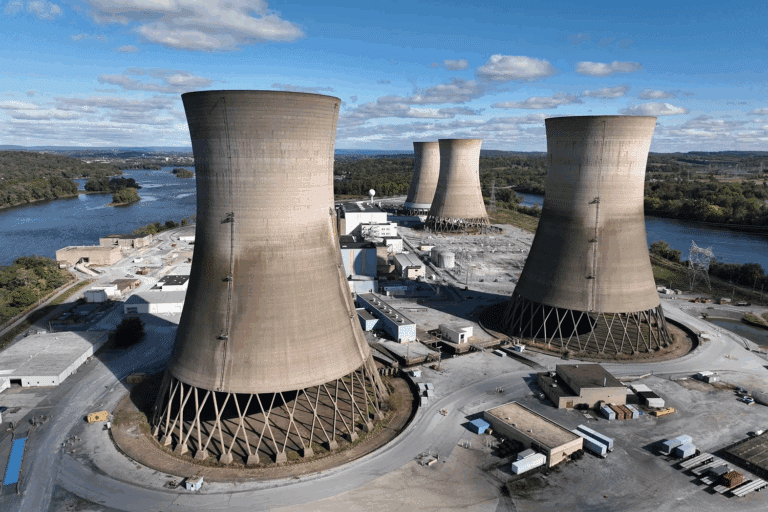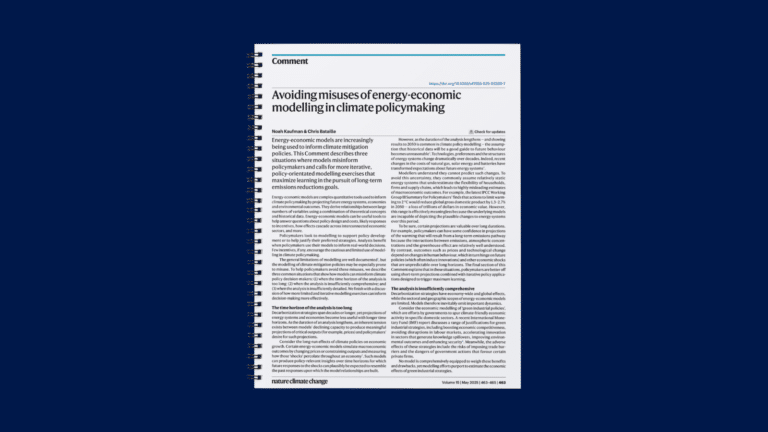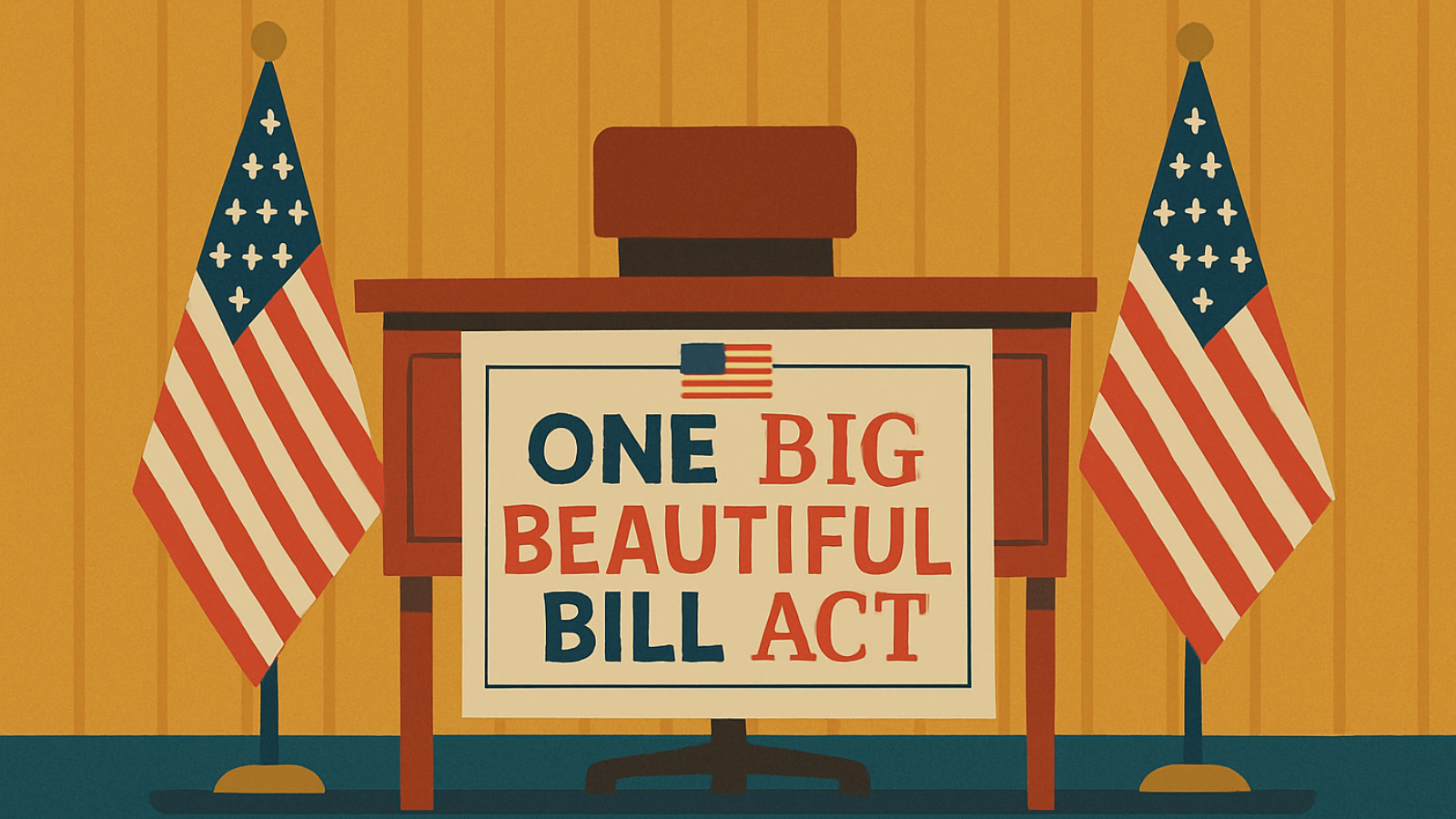This website uses cookies as well as similar tools and technologies to understand visitors’ experiences. By continuing to use this website, you consent to Columbia University’s usage of cookies and similar technologies, in accordance with the Columbia University Website Cookie Notice.
Energy Explained
Insights from the Center on Global Energy Policy
This Energy Explained post represents the research and views of the author(s). It does not necessarily represent the views of the Center on Global Energy Policy. The piece may be subject to further revision.
Contributions to SIPA for the benefit of CGEP are general use gifts, which gives the Center discretion in how it allocates these funds. More information is available here. Rare cases of sponsored projects are clearly indicated.
The One Big Beautiful Bill Act (OBBBA), signed into law by President Trump on July 4, 2025, significantly modifies clean energy tax incentives enacted under the Inflation Reduction Act of 2022 (IRA). Specifically, the bill scales back some of these incentives by tightening domestic content requirements and foreign entity restrictions and imposing new qualification deadlines, while phasing out others. These changes reflect the administration’s stated goals of expanding domestic fossil fuel production and rolling back federal support for clean energy and climate initiatives.
This special CGEP blog series, featuring six contributions from CGEP scholars, analyzes the potential impacts of the OBBBA across a range of sectors. The main takeaways are as follows:
Carbon capture and sequestration: The bill modifies the 45Q tax credit for carbon management to put projects that use captured carbon dioxide to increase oil production at parity with geologic storage programs, signaling a commitment to the American oil and gas industry. Oil production utilizing enhanced oil recovery will likely increase.
Low-emissions hydrogen: The bill is less damaging to low-emissions hydrogen than initially expected, but it remains less supportive than the IRA when it comes to renewable hydrogen and US electrolyzer manufacturers. Weaker prospects for domestic demand are likely to shift the focus toward a highly competitive and narrow export market.
Critical minerals: The bill boosts funding for critical mineral extraction; however, it reduces incentives for demand and processing. This could bolster China’s dominance in the midstream sector and undermine supply chains the United States has sought to secure.
Electric vehicles (EVs): The bill rolls back core EV and battery tax credits, which may threaten existing and new supply chain investments, lead to a drop in US EV sales, and strengthen China’s position in the global EV market.
Nuclear: The bill preserves the dates by which new nuclear projects need to start construction in order to qualify for the IRA’s major tax credits but creates some uncertainty around eligibility by introducing new restrictions for entities with ties to specified foreign countries.
Solar and wind: The bill’s spending cuts target IRA provisions primarily aimed at addressing climate risks, including subsidies for solar and wind energy. Rapidly phasing out these subsidies will leave more money in the federal treasury at the cost of slowing the pace of renewable power supply additions.
-
Carbon Capture and Sequestration
-
Changes made in the One Big Beautiful Bill Act (OBBBA) to the tax credits (45Q) companies receive for capturing carbon dioxide fit within President Trump’s oft-stated goals of global competitiveness, “drill baby drill,” and penalizing unfriendly nations. Indeed, one of the provisions in the bill could lead to an increase in the amount of oil produced through enhanced recovery, although ultimately, many factors will come into play.
The 45Q tax credit pays companies to capture carbon dioxide from industrial and power sources or using direct air capture (DAC). Historically, companies received higher credit amounts for storing the carbon permanently, as opposed to utilizing the carbon in materials or for enhanced oil recovery (EOR). The Biden administration increased the credit amounts for point source capture and DAC in the Inflation Reduction Act (IRA). This was done to incentivize the deployment of both carbon capture and sequestration (CCS) and DAC for their climate benefits and achieved early success.
The Trump administration made two notable changes to the tax credit in the OBBBA.
Foreign Entity of Concern (FEOC). As with other tax credits, an FEOC measure was included. However, unlike other credits, the FEOC for 45Q only applies to the entity claiming the tax credit, not to the supply chain or materials associated with the project, making it easier to comply with.
Parity between storage and utilization. This provision equalizes the credit amount for both CCS ($85/ton) and DAC ($180/ton), whether the carbon is stored permanently or used in products or for enhanced oil recovery.
The parity provision strengthens the economic case for both CCS and DAC, as the captured carbon can be used as a value-add for or in products. Captured carbon can be used to carbonate beverages, help cure concrete, or extract more oil from existing oil fields.
The decision to produce oil via EOR is complex and influenced by the quality of current inventories, enabling infrastructure, and the price of oil. Historically, companies needed an oil price of around $75/barrel for EOR to be economically viable. One CCS project, Petra Nova, had to shutter its capture facility after the price of oil dipped below that amount during the COVID-19 pandemic. The revision of 45Q in the OBBBA changes that calculus and may increase the production of oil from EOR in the United States.
EOR accounts for around 2 percent of the overall barrels produced worldwide and around 6 percent in the United States. However, the IEA has projected an increase in EOR production through 2040. The change in tax credit could position the United States to increase EOR market share. That projected EOR increase, coupled with carbon pricing regimes around the world, could raise the value of American EOR, as it can have a lower carbon content compared to standard produced barrels.
The increased credit amount likely means greater deployment of CCS, and potentially DAC. The climate benefits of this will need to be assessed on a project-by-project basis. It is not clear if this administration values the climate benefits of CCS and DAC, but what is clear is its commitment to US oil and gas production.
-
Low-Emissions Hydrogen
-
Now that the Trump administration’s One Big Beautiful Bill Act (OBBBA) has passed, it appears to be less damaging to US progress on low-emissions hydrogen than initially expected, but is still less supportive than the Inflation Reduction Act (IRA). On the supply side, support for low-carbon hydrogen remains unchanged, while support for renewable hydrogen is curtailed over time. Meanwhile, domestic demand for low-emissions hydrogen appears weaker, primarily due to uncertainties surrounding H2Hubs funding, potentially forcing the US to turn to highly competitive and limited export markets.
The Biden Administration’s low-emissions hydrogen strategy aimed to scale up clean hydrogen production and use to meet national sectoral decarbonization goals. It received major backing from the 2021 Bipartisan Infrastructure Law (BIL) and the 2022 IRA. The BIL appropriated $9.5 billion in funding for clean hydrogen through the Department of Energy (DOE), including $7 billion for seven hydrogen hubs (H2Hubs) that were selected in October 2023, and $1 billion for demand-side support. The IRA seemed to mark a pivotal moment for the US hydrogen industry: its generous 45V production tax credits (PTC) of up to $3/kilogram based on carbon intensity, an increase upon the existing 45Q (supporting low-carbon hydrogen), and technology-neutral approach instantly made the US appear as one of the world’s most attractive hydrogen markets. As of May 2024, the US had 1.6 Mt of hydrogen projects having reached FID, more than any other country, including China (with 1.4 Mt). However, most of these projects were supported by 45Q. Delays in the Department of the Treasury’s final rules on 45V held back renewable hydrogen projects.
The OBBBA shortens the deadline for 45V PTCs for hydrogen projects by five years. While this still allows time for projects to start construction (by the end of 2027), the administration’s unfavorable stance on wind and solar, coupled with intensifying competition for electricity driven partly by growing demand from data centers, could limit the number of renewable hydrogen projects that move forward. One potential exception is low-carbon hydrogen projects aiming to qualify for 45V based on low methane emissions. Meanwhile, the bill leaves the 45Q deadline of 2032 and $85/ton PTC largely unchanged, continuing support for low-carbon hydrogen.
Given this continued, if curtailed, support for clean hydrogen supply, the bill is unlikely to stop US development in the sector, but it may reinforce the trend toward low-carbon hydrogen projects supported by 45Q. That said, supply projects will need offtakers, and domestic demand for clean hydrogen (especially renewable) has been weak — a situation that is unlikely to change given the new administration’s limited regulatory pressures on reducing emissions, the high cost of renewable hydrogen, and the uncertain outlook for hydrogen hubs (pending the DOE’s review of programs). Hubs rumored to face cuts had planned to use renewable and nuclear power to produce hydrogen, further weakening the outlook for domestic demand for renewable hydrogen. Moreover, a recent DOE audit found that the Office of Clean Energy Demonstrations lacked proper planning and resources for the H2Hubs Program, which may lead to a focus on fewer (mostly low-carbon) hubs.
As a result, hydrogen project developers and electrolyzer manufacturers may increasingly turn to export markets — though these remain narrow and highly competitive, with importers scrutinizing the carbon intensity of imported hydrogen and derivatives. Beginning in 2028, US competition in renewable hydrogen exports will fade, opening opportunities for projects in the Middle East, Latin America, and Africa, while in the absence of a domestic market, US electrolyzer manufacturers may lose out in their competition against China.
-
Critical Minerals
-
The One Big Beautiful Bill Act (OBBBA) represents a mixed bag for US critical minerals development. While the bill ramps up extraction funding, it guts demand and key incentives for processing. This could widen, not close, America’s critical mineral gap with China.
On the one hand, the bill expands federal support for domestic mineral extraction, appropriating $5 billion to the Department of Defense’s Industrial Base Fund for critical mineral supply chain investment, plus $2 billion for strategic stockpiling and $500 million to leverage up to $100 billion in project development loans and guarantees. This represents a meaningful shift from the more piecemeal approach to directly funding critical mineral supply chains of the Biden administration. Combined with recent executive orders on critical minerals, it signals a more interventionist White House willing to prioritize resource security. In that sense, Trump’s approach mirrors historical US strategies on oil: secure extraction to reduce import dependency.
But if end-to-end industrial strength is the goal, the bill also leaves some gaps unaddressed and includes some serious setbacks. Unlike with oil, the US lacks a mature domestic processing and refining base for most key critical minerals. This is also where China dominates, in many cases accounting for over 60 percent of global processing and refining. The bill includes no provisions to address this issue; in fact, it repeals or phases out key measures introduced by the Biden administration that were put in place precisely to spark processing and midstream capacity building.
These measures included the 30D New Clean Vehicle Credit and other clean energy tax credits as well as the 45X Advanced Manufacturing Production Credit. The former was originally intended to increase demand for electric vehicles coupled with local content requirements that necessitated domestic production of batteries and battery components as well as production of critical minerals in Free Trade Agreement partners. Eliminating it will erode much of the demand pull for critical mineral investments, making it more difficult to finance critical minerals projects. National defense applications are important, but the demand from them is much smaller than that from the clean energy sector.
The 45X credit was meant to incentivize domestic processing of clean energy components, including critical minerals. Under the Inflation Reduction Act, the 45X credit for critical minerals did not phase out at all, reflective of the long-term and capital-intensive nature of critical mineral mining and processing. The final 45X rule under the Biden administration also included direct and indirect material costs, which was a significant upgrade to lower competitiveness disadvantages of US processors. The tax credit will now be phased out for critical minerals starting in 2031, which reduces the attractiveness for processors as it takes several years and a great deal of capital to get a processing project up and running. The fact that 45X is a production credit and not an investment credit means that it is far less attractive for financing new processing infrastructure.
The OBBBA will likely go some way toward expanding US critical mineral investment. But a resilient US supply chain requires more than increased extraction; it also needs processing and midstream capacity development, and urgently so. On this latter front, the bill falls short, and may even be a setback.
-
Electric Vehicles
-
US electric vehicle (EV) manufacturing and competitiveness will be hard hit by President Trump’s One Big Beautiful Bill Act (OBBBA). The bill’s rollback of US EV tax credits may serve Trump’s goals of saving federal dollars in the short term, but it could create significant risks for the United States in the long term. The measures will likely reduce domestic demand for EVs, cede EV market share to foreign competitors (especially China), and jeopardize battery investments and innovation that underpin electric mobility.
The Biden-era Inflation Reduction Act (IRA) and Infrastructure Investment and Jobs Act (IIJA) deployed historic subsidies to jumpstart US EV adoption and manufacturing in an effort to enter the United States into a global race largely dominated by China. The IRA’s $7,500 new EV credit (30D), $4,000 used EV credit (25E), 45W commercial EV credit, and 45X production tax credit for batteries spurred domestic sales, manufacturing, and investment, while the IIJA funded nationwide charging infrastructure. These policies helped EVs surpass 8 percent of new US car sales in 2023 and anchored over $110 billion in announced battery and EV supply chain investments.
Trump’s bill takes three big swipes at these IRA policies and EVs.
First, it terminates the 30D and 25E consumer credits, ends the widely used 45W commercial EV credit, and sets a hard sunset for the 45X battery production credit by 2033. Market predictor Rho Motion projects US EV sales to fall by over 40 percent through 2030. This is because 50 percent of EVs sold in the United States received the $7,500 tax credit and because the leasing tax credit meant that about two-thirds of EVs sold recently were for leased EVs. The weakened 45X incentive further blunts US efforts to compete with China’s battery dominance. In a world where battery cost is the primary driver of EV competitiveness, this effectively means that the ever-growing global EV market is ceeded to China.
Second, it undercuts the ability of Tesla and any other company that produces EVs to profit from regulatory credit sales by eliminating federal penalties for automakers that miss fuel economy (CAFE) standards. The new bill doesn’t end the CAFE standards but effectively ends any civil penalties under the Transportation Department’s fuel economy rules for not reaching them. While Tesla is not the only company that produces only EVs, it is by far the largest, and the impact of the changes on its business could prove substantial, as credit sales have been hugely important for Tesla across the world, delivering $595 million of revenue in Q1 2025 alone. With Tesla sales falling in the United States and Europe, this poses a significant risk to the largest Western EV champion with a global scale.
And third, it introduces a new auto loan interest deduction for certain US-assembled vehicles through 2028, limited in terms of amount and household income. The deduction allowance largely benefits the early purchasing of lower-cost domestic gas cars, again increasing the incentive for consumers to switch away from EVs.
In addition to the impact on EVs discussed, the cuts to tax credits could reduce demand for critical minerals and batteries, in turn making financing for such projects more difficult. This could hamper efforts to diversify supplies of the critical minerals that fuel the digital economy and the national security sectors.
-
Nuclear
-
By Dr. Matt Bowen and Dr. Ashley Finan
The One Big Beautiful Bill Act (OBBBA) preserves key federal support for nuclear, including access to tax credits established under the Inflation Reduction Act (IRA) and the Department of Energy’s loan program. It adds resources to accelerate micro-reactor development for military use, though also adds foreign entity provisions for the IRA tax credits, which could constrain their use for new commercial plants depending on implementation.
New nuclear projects remain eligible for the IRA’s two main clean electricity tax credits: the Section 45Y production tax credit (PTC) and the Section 48E investment tax credit (ITC). As with the original IRA text, new nuclear projects must start construction by 2033 to get the full benefit of these credits. As with other technologies, the OBBBA introduces restrictions on eligibility for entities with ties to specified foreign countries. The scope and impact of these restrictions will depend on future regulatory guidance and how the Department of the Treasury defines foreign influence. The bill also adds “nuclear energy communities” to the definition of “energy communities” under Section 45. This change could allow certain projects, including uprates or restarts, to qualify for a 10 percent bonus to the 45Y credit, depending on how eligibility is interpreted.
Support for existing plants is maintained through the 45U credit for zero-emissions electricity, though access has been narrowed. After 2027, projects using nuclear fuel from countries such as Russia or China will no longer qualify, unless the fuel was secured under contracts signed before 2023.
Beyond tax credits, the bill makes structural changes to the Department of Energy’s Loan Programs Office (LPO), which has been an important source of financing for large-scale energy infrastructure, including nuclear. It eliminates language from the Energy Policy Act of 2005 that directed LPO funding to projects that “enable operating energy infrastructure to avoid, reduce, utilize, or sequester air pollutants or anthropogenic emissions of greenhouse gases,” and removes the requirement that new fossil fuel projects include emissions controls. The bill also broadens eligibility to include fossil and critical minerals projects, along with nuclear and other technologies that enhance grid reliability. The bill extends commitment authority for the LPO by two years, from September 30, 2026 to September 30, 2028, and adds $1 billion for the LPO to carry out activities.
Generally, while the bill rescinds funds for LPO commitments to specific renewable energy technologies, the LPO’s ability to support nuclear energy projects remains unchanged. The broadening of the LPO’s authority to support fossil and critical minerals projects could limit the commitment authority available for nuclear energy if many fossil and mineral projects are supported.
In line with its national security emphasis, the bill provides $125 million for “the acceleration of development of small, portable modular nuclear reactors for military use” as outlined in section 20005. The funding could be intended to support existing military micro-reactor projects and to accelerate the implementation of priorities set out in the administration’s May 23, 2025, executive order on advanced nuclear technologies for national security.
Overall, the provisions in the bill relating to nuclear energy leave unchanged existing subsidies for the deployment of new commercial reactors. The new foreign entity provisions that apply to the IRA tax credits may adversely impact the utilization and impact of those credits, but the effects will depend on implementation details. The bill also provides funding to accelerate development of micro-reactors for military use.
-
Solar and Wind
-
Consistent with the Trump administration’s broader rollback of US climate policies, the One Big Beautiful Bill Act (OBBBA) introduces spending cuts targeted at provisions of the Inflation Reduction Act (IRA) that were primarily aimed to address climate risks, including subsidies for solar and wind.
While often grouped together in a single bucket, the clean energy provisions of the IRA differed across important dimensions. The OBBBA largely leaves intact the incentives that support technologies with little current role in the energy mix, such as enhanced geothermal and next generation nuclear energy.[1] Subsidies for promising emerging technologies are relatively inexpensive, and they can be justified by the boost they offer to energy innovation and associated gains to economic productivity, which are broadly shared goals. In contrast, solar and wind energy[2] have become cost competitive over the last decade[3] and are the source of most new electricity capacity in the US. The bill phases out tax credits for solar and wind over roughly two years, though within days of its passage Trump seemingly ordered federal agencies to end them sooner.
The IRA’s solar and wind incentives were key components of President Biden’s climate strategy, which aimed to align federal policy with emissions goals. Rapidly deploying solar and wind offered unrivaled potential for near-term emissions reductions.[4] In addition, Biden’s strategy sought to prepare the US economy for an impending global energy transition by building domestic renewable energy supply chains, currently dominated by China. To that end, the IRA’s tax credits included bonuses for using US-made equipment, complemented by separate incentives to spur domestic clean tech manufacturing.
In contrast, President Trump has eliminated US climate goals and has an energy policy strategy that emphasizes expanding fossil fuel production. The Trump administration argues that subsidies for mature, intermittent technologies like solar and wind distort energy markets and harm grid reliability.
Repealing the solar and wind tax credits effectively transfers funds to the federal treasury that would have been provided to energy developers (and, indirectly, to energy consumers in the form of lower electricity prices). It will also lead to less wind and solar on the US grid, although the precise impacts are uncertain because they depend on how market participants and regulators respond. Some projects will be canceled, while others will rush to meet deadlines or proceed without federal support.
[1] New Foreign Entity of Concern requirements, which limit subsidies to countries that pose potential economic or security threats to the United States, could complicate this analysis.
[2] Technically, these subsidies were designed to transition into a technology-neutral investment tax credit and production tax credit for carbon-free electricity sources, with solar and wind projects expected to receive the bulk of the funds.
[3] Utility-scale solar PV and land-based wind are competitive with alternative sources of electricity generation in many places. In contrast, residential rooftop solar PV and offshore wind still typically require a large cost premium.
[4] Through channels including learning-by-doing, faster deployments also contribute to lowering the costs of these technologies.
More on Energy Explained Energy Explained
MP Materials Deal Marks a Significant Shift in US Rare Earths Policy
The US Department of Defense has announced a multibillion-dollar public-private partnership with MP Materials.

Q&A: An Energy Take on the Current State of the Iran-Israel-US Conflict
The conflict between Iran, Israel, and now the United States has yet to disrupt energy supplies to global markets.

Trump’s Seismic, Irrevocable Middle East AI Shift
The commercial deals Trump struck on artificial intelligence cooperation will likely shift the global balance of power for one of this century's most critical technologies.

Q&A: Why Trump’s Gulf Tour Matters for Energy, AI, and Geopolitics
President Donald Trump's first official foreign policy trip, as in his first term, was to Saudi Arabia earlier this month, with additional stops in Qatar and the United Arab Emirates.

Relevant
Publications
The United States Needs a Nuclear Operation Warp Speed
A nuclear energy resurgence is vital to meet rising electricity demand.

Columbia India Energy Dialogue: Event Summary

Avoiding Misuses of Energy-Economic Modeling in Climate Policymaking
Energy-economic models are increasingly being used to inform climate mitigation policies. This Comment describes three situations where models misinform policymakers and calls for more iterative, policy-orientated modelling exercises that maximize learning in the pursuit of long-term emissions reductions goals.


